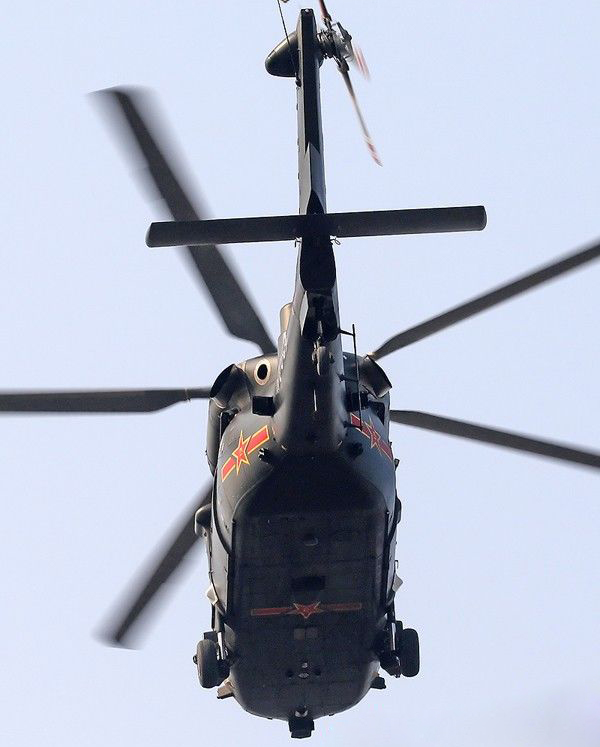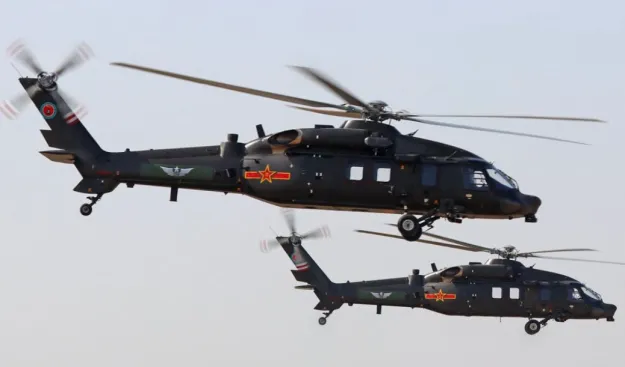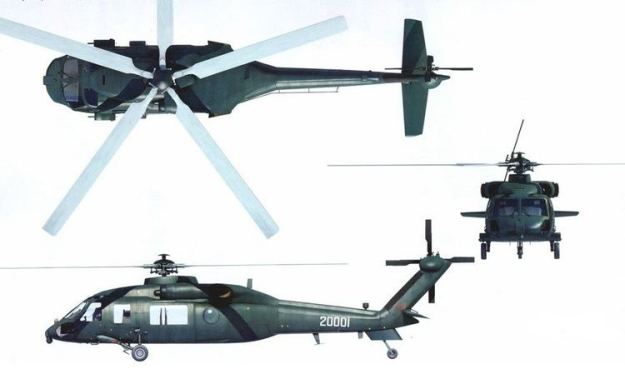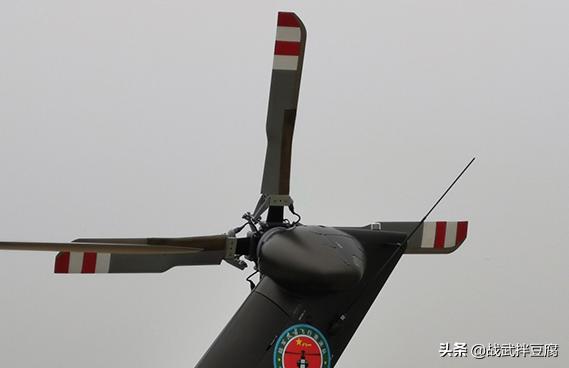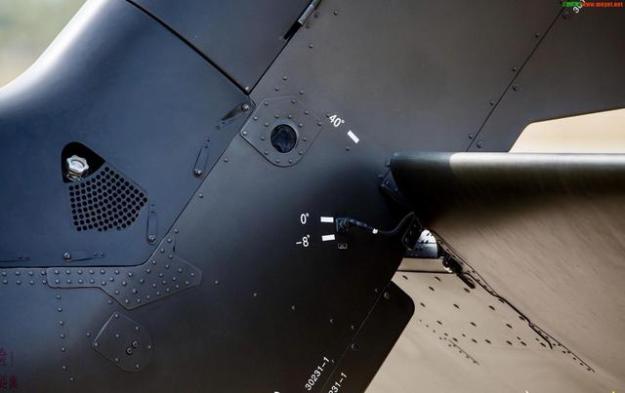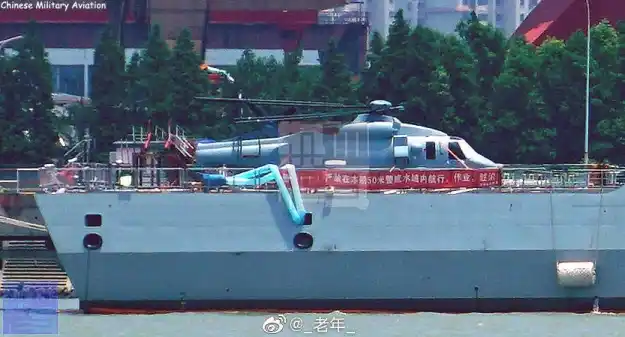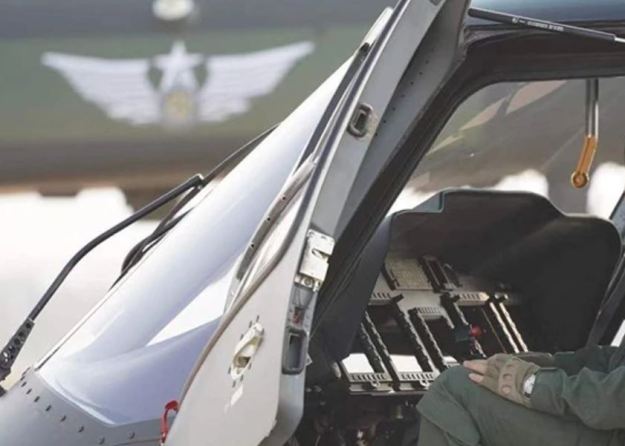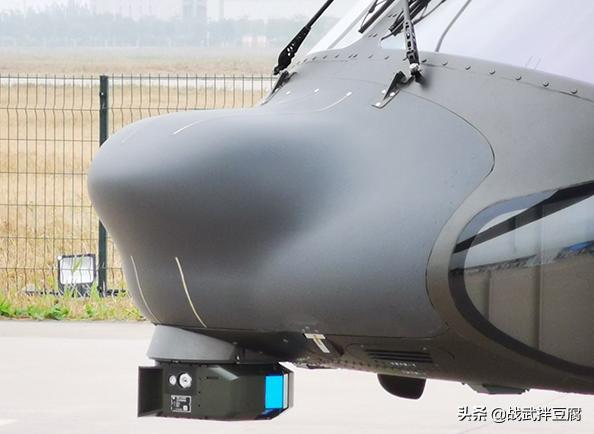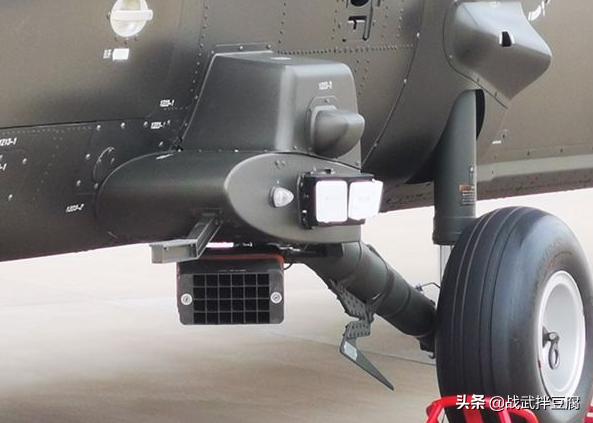The Z-20 helicopter is a new medium-lift utility helicopter operated by China’s People’s Liberation Army Ground Force.
The Z-20 helicopter is a new medium-lift utility helicopter operated by China’s People’s Liberation Army Ground Force.
The helicopter resembles the UH-60 Black Hawk twin-engine rotorcraft built by Sikorsky. The Z-20 entered active service with the Chinese armed forces in 2018.
First flight

The Z-20 gets air under its wheels for the first time at a snowy location in China, almost certainly at the Harbin factory. (Photo via Chinese internet)
China’s newest military helicopter made its first flight on December 23 at a location in “northeastern China,” a site presumed to be the Harbin facility. The aircraft, believed to be designated Z-20, is in the “10-tonne” class, and is thought to be a collaborative effort among Harbin, Changhe and the 602 Institute. It closely resembles the Sikorsky S-70 Black Hawk that has been in Chinese army service for nearly three decades. The first public glimpse of the Z-20 came in August 2013, when the heavily wrapped fuselage was photographed being transported by road.
China acquired 24 Sikorsky S-70C-2s in the mid-1980s, and they were pressed into service with the army for missions in the mountainous regions of China, such as Tibet, where their high-altitude performance greatly impressed the People’s Liberation Army. With further supplies and spares support from the U.S. cut off after 1989, the army began acquiring sizeable numbers of Mi-17/171s from Russia, while Changhe began to reverse-engineer parts to keep the S-70 fleet flying. This work, and access to live examples, allowed the Z-20 design team to draw heavily on the Sikorsky helicopter. Some sources allege that Pakistan allowed Chinese engineers access to the heavily modified Black Hawk destroyed during the bin Laden raid.
Although strikingly similar to the S-70, the Z-20 exhibits some differences, the most notable of which is a five-blade main rotor instead of the Black Hawk’s four-blade unit. Compared with the Black Hawk’s, the Z-20’s cabin is longer and wider, while the main rotor head appears to be positioned farther aft, making the forward fuselage seem longer than that of the S-70. The undercarriage and tail also show differences.
In terms of powerplant and dynamics, it is likely that the Z-20 draws on the same technology as employed in the Z-10 attack helicopter. Both have their roots in the China Medium Helicopter (CMH) program of the late 1990s, for which Western help was received. The prototype Z-20 may be powered by the indigenous WZ-6C turboshaft, with the more powerful (1800 kW) WZ-10 slated for production machines.
Development of a utility helicopter that can be used for assault, fire support, electronic warfare and special-operations missions is seen as important to the development of PLA Army Aviation. However, it is understood that the development of the Z-20 was delayed while the design team focused on the higher priority Z-10. As well as augmenting and expanding the army’s helicopter fleet, the Z-20 could also find a use at sea, particularly aboard the aircraft carrier Liaoning. Source ainonline.com
Manufactured by Chinese state-owned aerospace and defence firm Aviation Industry Corporation (AVIC) subsidiary Harbin Aircraft Industry Group, the helicopter performed its maiden flight in 2013. The Z-20 made its first public presence during China’s 70th National Day military parade in Beijing in October 2019.
The rotorcraft also performed a demonstration flight at the fifth China Helicopter Exposition held in Tianjin in October 2019. The Z-20s were presented as the static and close-formation flying displays at the event.
Designed to meet the People’s Liberation Army’s requirement for a medium-lift utility helicopter, the Z-20 is considered to be the country’s first indigenously developed medium-lift helicopter.
The development started in 2006 but was delayed due to technical issues and a shift of focus towards the development of the Z-10 attack helicopter.
Z-20F, the ship-borne naval variant, has some similarities with the US Navy’s Seahawk design.
Images suggest Z-20 helicopter has entered service with China’s PLAGF
Production versions of the Harbin Z-20 helicopter appear to have entered service with an aviation unit of China’s People’s Liberation Army Ground Force (PLAGF), as evidenced by photographs published on Chinese online forums.
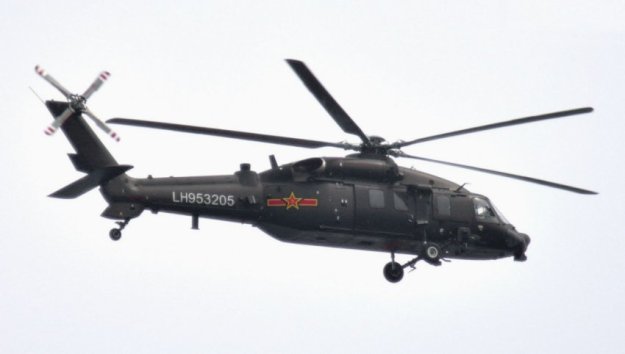
A Chinese Z-20 helicopter bearing the number LH953205: a serial number format indicating that this rotorcraft type has likely entered service with the PLA Army Aviation. (Via haohanfw.com)
Although images of the Z-20 had previously emerged online, they had shown the platforms with either no serial numbers or only three-digit numbers, indicating that these were development or pre-production aircraft. The latest photographs, however, show two helicopters featuring serial numbers LH953201 and LH953205: the serial number format for aircraft in service with PLA Army Aviation.
The Z-20 is a medium utility helicopter in the 10-ton class. There have been many comments that the design is derived from the Sikorsky S-70C/Black Hawk, in part due to similarities in appearance but also because China bought 24 S-70C helicopters from the US in 1986: three years before the Tiananmen Square-related arms embargo was imposed.
There are, however, notable differences between the US and Chinese helicopters, not least in the use of a five-bladed main rotor in the Z-20 rather than a four-bladed one in the S-70. The Z-20 is thought to be powered by two WZ-10 turboshaft engines, each developing 1,600 kW, which would mean an increase of about 200 kW over that provided by the General Electric T700-701A turbines used in the exported S-70Cs. Source janes.com
Z-20 design and features
The Z-20 is widely believed to have been designed on the basis of the Sikorsky S-70 Black Hawk that was procured from the US. The Black Hawk fleet has been in service with China for over three decades. The Z-20 helicopter is identical to the Black Hawk in terms of shape, size and layout.
The Z-20 helicopter has an improved aerodynamic structure, integrating a five-bladed rotor and an angular tail-to-fuselage joint frame. It features two fairings, one installed aft of the engine exhausts and the second on the tail spine. The rotorcraft employs an active vibration control to minimize vibrations.

The rear tail wheel is wrapped by a light fairing, which reduces aerodynamic drag and slightly helps heading stability, which indirectly reduces the size of the vertical tail and further reduces weight. Source new.qq.com
Harbin incorporated advanced technologies into the helicopter design to reduce noise and improve stealth capabilities. Manned by a crew of two personnel, the helicopter has a take-off weight of 10t.
Naval version
According to pictures released by the China Defense Blog on June 20, 2020, the Chinese Navy has commissioned Z-20F also called Z-20J by other Chinese sources, a naval version of the Chinese-made Harbin Z-20 medium-lift utility helicopter produced by the Harbin Aircraft Industry Group (HAIG). A picture of the naval version of the Z-20 was unveiled on the Twitter account of Mike Yeo on October 14, 2019.
The new Z-20F helicopter is a modified version of the Z-20 designed to perform Search And Rescue operations like the American SH-60 Sea Hawk helicopter. The Z-20 layout is very similar to the Black Hawk helicopter but there are several key differences including a five-bladed main rotor and more angular tail-to-fuselage joint frame, giving it greater lift, cabin capacity, and endurance than the Black Hawk, as well as a fly-by-wire design.
The Z-20J can be operated from the small decks of warships. According to information released by the Drive website, it features apertures for a missile approach warning system (MAWS) and it has a landing gear arrangement similar to SH-60B/F and MH-60R Seahawks.
A square hole similar to those found on Seahawk and other maritime-optimized helicopters that use the RAST (Recovery Assist, Secure and Traverse) system for recovery is also clearly seen.
The helicopter’s tail boom holds a number of features, including a downward-facing UHF communications antenna and a directional data-link antenna under a dome. These are key components that give the Z-20F the capability to send large amounts of information to receivers that are located on the surface of the earth within line-of-sight. Source navyrecognition.com
Attack Version
Mission capabilities of Z-20
The multi-role helicopter was designed to operate in plateaus such as the Tibet Autonomous Region and in challenging weather conditions. It can be deployed in multiple missions including transport of troops and cargo, reconnaissance, search and rescue, and anti-submarine operations. In addition, the helicopter can perform assault and fire support missions.
The Z-20 can carry more than 11 troops. The internal payload capacity of the helicopter is approximately 1.5t, while the rotorcraft can also carry approximately 5t of cargo externally as a sling load. The Z-20 has the option to be armed with missiles and machine guns.
Z-20 cockpit and avionics
Z-20’s cockpit has large windows that occupy more than 50% area of the helicopter’s forward fuselage. It has two additional windows at the lower section to provide pilots with a wide view of the operational area.
The control panels in the cockpit feature multifunctional screens. The rotorcraft is equipped with a fly-by-wire flight control system, making it the first China-made helicopter to use the advanced technology.
The incorporation of the fly-by-wire technology is intended to reduce the burden on the pilot and enhance safety and stability during operations.
The helicopter is also equipped with a missile approach warning system (MAWS) and flare decoy dispensers.
Generic Navigation Radar
The helicopter features a glass cockpit with at least 5 MFDs. Shoulder armor plates were installed to protect the pilots. It also features a box shaped PNVS mounted underneath the chin controlled by pilot’s HMD and twin RWR antennas on both sides of the forward and rear fuselage. LWR sensors have been installed on both sides of the nose with ECM antennas on the top. A new IFF antenna was installed on the cockpit roof. A weather radar and a terrian following radar were integrated in the nose. A SATCOM antenna, two pairs of chaff/flare dispensers plus a Beidou antenna were installed on the tail boom. An FBW flight control system was installed. Active noise/vibration reduction technology was used. Source chinese-military-aviation.blogspot.com
| General data: | |
|---|---|
| Type: Radar | Altitude Max: 0 m |
| Range Max: 37 km | Altitude Min: 0 m |
| Range Min: 0.4 km | Generation: Early 1970s |
| Properties: Pulse-only Radar |
| Sensors / EW: |
|---|
| Generic Navigation Radar – Radar Role: Radar, Navigation Max Range: 37 km |
Source cmano-db.com
Generic FLIR – (2nd Gen, Surveillance, 8x Magnification) Infrared
| General data: | |
|---|---|
| Type: Infrared | Altitude Max: 0 m |
| Range Max: 55.6 km | Altitude Min: 0 m |
| Range Min: 0 km | Generation: Infrared, 2nd Generation Imaging (1980s/1990s, LANTIRN, Litening) ) |
| Properties: Identification Friend or Foe (IFF) [Side Info], Classification [Class Info] / Brilliant Weapon [Automatic Target Aquisition], Continous Tracking Capability [Visual] |
| Sensors / EW: |
|---|
| Generic FLIR – (2nd Gen, Surveillance, 8x Magnification) Infrared Role: Infrared, Surveillance Camera Max Range: 55.6 km |
Source cmano-db.com
Generic RWR – ESM
| General data: | |
|---|---|
| Type: ESM | Altitude Max: 0 m |
| Range Max: 222.2 km | Altitude Min: 0 m |
| Range Min: 0 km | Generation: Late 1970s |
| Sensors / EW: |
|---|
| Generic RWR – ESM Role: RWR, Radar Warning Receiver Max Range: 222.2 km |
Source cmano-db.com
KD-10 air-to-surface missile
The latest image (December 2021) suggested that an armed variant (Z-20W?) has been undergoing test flight while carrying KD-9/10 ATGMs and fuel tanks under the stub wings. The latest video (February 2021) indicated a new batch of Z-20s have engine exhausts facing upward to reduce their IR signature. Source chinese-military-aviation.blogspot.com
| General data: | |
|---|---|
| Type: Guided Weapon | Weight: 50.0 kg |
| Length: 1.2 m | Span: 0.3 m |
| Diameter: 0.15 | Generation: None |
| Properties: Terminal Illumination, Terrain Following, Level Cruise Flight |
| Targets: Surface Vessel, Land Structure – Soft, Land Structure – Hardened, Mobile Target – Soft, Mobile Target – Hardened |
| Sensors / EW: |
|---|
| Laser Spot Tracker – (Generic, Weapon) Laser Spot Tracker (LST) LST, Laser Spot Tracker Max Range: 27.8 km |
| Weapons: |
|---|
| HJ-10 ATGM – Guided Weapon Surface Max: 9.3 km. Land Max: 9.3 km. |
Source cmano-db.com
Engines of Z-20 helicopter
The Z-20 helicopter is powered by two locally developed WZ-10 turboshaft engines. The engine is expected to deliver a maximum power of 1,600kW.
Specification
The Z-20 has a crew of two and can accommodate around 12-15 fully-equipped troops. It has a payload capacity of around 5 000 kg. It can carry around 1,000 kg internally and 4,000 kg externally. It can transport various loads, such as vehicles and artillery pieces underslung externally. Source navyrecognition.com
Main material source army-technology.com
Images are from public domain unless otherwise stated
Main image by min.news


